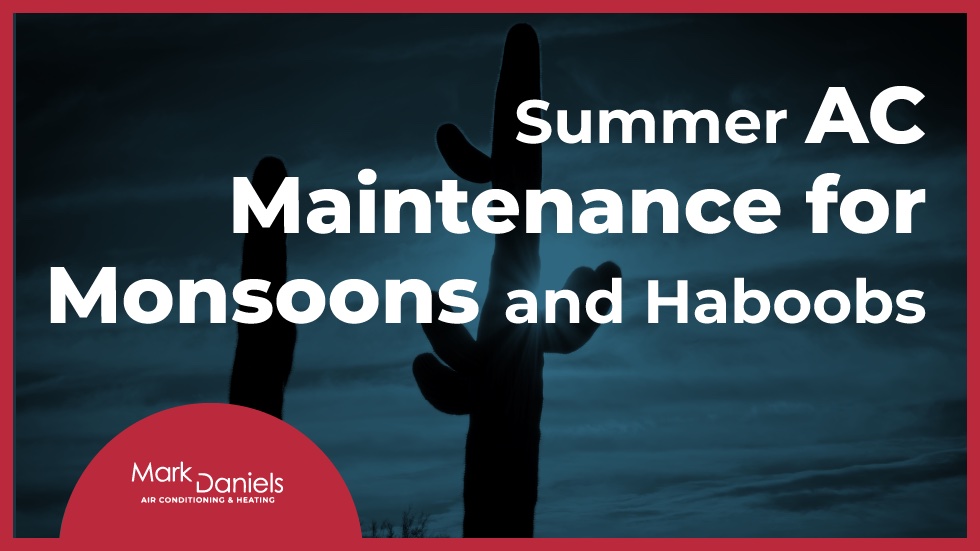Licensed | Bonded | Insured

Summer AC Maintenance for Monsoons and Haboobs
Here in the Chandler area, monsoon season is a reality we have to deal with.
Monsoons and haboobs may not last long but they can do quite a bit of damage.
And because our air conditioning units exist outside, they’re often subject to this damage.
Fortunately, there are things you can do to help keep this damage to a minimum.
Wondering how to prepare for monsoon as it pertains to your AC unit?
Here is your guide to summer AC maintenance for monsoons and haboobs.
Replace the Air Filter Frequently
Your AC’s air filter works to keep airborne contaminants out of your AC.
In doing so, it maintains energy efficiency and prevents undue wear and tear.
Unfortunately, when monsoon and haboob season come around, they subject the air filter to many more contaminants than what they typically need to contend with.
As such, the filter wears out quicker and has more trouble doing its job.
The solution? Change your air filter more frequently than you normally do.
Instead of changing your air filter every 2 to 3 months, change it every month.
This will help your AC to stay strong against the swaths of dust and humidity, ensuring that your home stays cool and that your AC lives as long a life as possible.
Keep the Condenser Area Clear
When monsoons and haboobs come calling, they have the potential to throw large objects all over the place.
From trampolines to trash cans to lawn ornaments and more, these natural weather events will toss them through the air with little issue.
Should one of these wind-thrown objects make contact with your AC condenser, it could cause substantial damage.
This is why, during monsoon and haboob season, you need to be sure to keep the area around your condenser clear.
Leave a good 10 to 15 feet of clearance on all of its sides.
If you have large objects in your yard, try to keep them inside.
Have trees planted in your yard?
If so, you should trim them up as much as possible.
Doing so will reduce the risk of broken branches, and the fewer broken branches that fall into your yard, the safer your condenser will be.
In essence, do whatever is necessary to minimize damage.
Consider what high winds are capable of and do everything possible to negate those capabilities.
Employ a Surge Protector
When haboobs and monsoons come around, the potential for lightning strikes increases.
Should lightning strike one of your power lines, it will cause a surge through your electrical system.
This could overpower your AC, causing it to break down.
You don’t want to be without AC in the middle of the summer.
Not to mention, the repair for this would be expensive.
Therefore, you’re strongly advised to add a surge protector to your electrical system.
A surge protector will prevent power surges from coming through your circuitry, protecting your AC in the process.
Interested in installing a surge protector?
Your local electrician can help you with the installation.
Clean Your Unit After Every Storm
Our next piece of advice is to clean your unit after every storm.
This will prevent the accumulation of excess residue, ensuring that your air conditioner continues to run at max capacity.
Not only should you clean the outside of your unit but its interior components as well.
These include its coils, its fan, its fins, and the like.
Now, failing to clean these components once after a storm isn’t going to result in any substantial problems.
However, if you allow them to go uncleaned after every storm, problems will undoubtedly begin to arise.
Keep the Condenser Fins Straight
On the outside of your condenser unit is an array of thin metal strips known as fins.
These fins protect the internal components of your condenser while allowing the condenser to take in new air.
Unfortunately, high winds and heavy impact can cause them to become bent and misshapen.
When this occurs, they compromise the efficiency of the AC unit and therefore hurt its operation.
This is why, during monsoon season and otherwise, you need to be sure to keep these fins straight.
Run a knife between each and every one of them until there’s a visible gap present.
This will enable your condenser to do its job properly, even during the heaviest of storms.
Schedule a Professional Tune-up
There are all sorts of things that you, the homeowner, can do to maintain your AC in the face of monsoons and haboobs.
However, your efforts alone likely won’t be enough.
See, in addition to the maintenance that you provide to your AC, you should also receive maintenance help from a professional.
In other words, you should schedule a professional tune-up.
This should occur at least once yearly.
That said, considering the severity of the haboob and monsoon season in this area, two tune-ups a year would be ideal.
Why is a professional tune-up necessary?
Because professional HVAC technicians notice things that everyday homeowners don’t.
They understand air conditioners on a higher level and therefore tend to catch problems that DIYers miss.
Catching these problems can go a long way in optimizing the efficiency and performance of an air conditioner.
Optimal efficiency and performance are integral during monsoon season.
Need Help With AC Maintenance for Monsoons and Haboobs?
There’s quite a bit that goes into AC preparation for monsoons.
Need help with AC maintenance for monsoons and haboobs in Chandler?
If so, we here at Mark Daniels Air Conditioning & Heating are the ones to see.
We’re well-versed in the maintenance of air conditioning units and know exactly how to prepare for a monsoon or haboob.
Regardless of the unit that you use, we can assist you.
Contact us today to get the process started!
Keep your unit running at its peak with AC maintenance for monsoons and haboobs. Call Mark Daniels Air Conditioning & Heating to work with a top air conditioning maintenance and repair company in Chandler, AZ. We’ve been serving the Valley Since 1996. Call (480) 571-7219 or request service online today!
Read More about Air Conditioning & Heating Tips:



